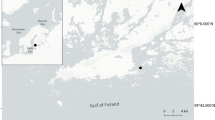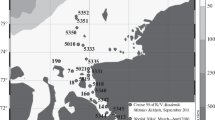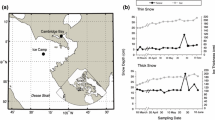Abstract
Although winter conditions play a major role in determining the productivity of the western Antarctic Peninsula (WAP) waters for the following spring and summer, a few studies have dealt with the seasonal variability of microorganisms in the WAP in winter. Moreover, because of regional warming, sea-ice retreat is happening earlier in spring, at the onset of the production season. In this context, this study describes the dynamics of the marine microbial community in the Melchior Archipelago (WAP) from fall to spring 2006. Samples were collected monthly to biweekly at four depths from the surface to the aphotic layer. The abundance and carbon content of bacteria, phytoplankton and microzooplankton were analyzed using flow cytometry and inverted microscopy, and bacterial richness was examined by PCR–DGGE. As expected, due to the extreme environmental conditions, the microbial community abundance and biomass were low in fall and winter. Bacterial abundance ranged from 1.2 to 2.8 × 105 cells ml−1 showing a slight increase in spring. Phytoplankton biomass was low and dominated by small cells (<2 μm) in fall and winter (average chlorophyll a concentration, Chl-a, of, respectively, 0.3 and 0.13 μg l−1). Phytoplankton biomass increased in spring (Chl-a up to 1.13 μg l−1), and, despite potentially adequate growth conditions, this rise was small and phytoplankton was still dominated by small cells (2–20 μm). In addition, the early disappearing of sea-ice in spring 2006 let the surface water exposed to ultraviolet B radiations (UVBR, 280–320 nm), which seemed to have a negative impact on the microbial community in surface waters.





Similar content being viewed by others
References
Arrigo KR (1994) Impact of ozone depletion on phytoplankton growth in the Southern Ocean: large-scale spatial and temporal variability. Mar Ecol Prog Ser 114:1–12. doi:10.3354/meps114001
Arrigo KR, Thomas DN (2004) Large scale importance of sea ice biology in the Southern Ocean. Antarct Sci 16:471–486. doi:10.1017/S0954102004002263
Arrigo KR, Dijken GV, Pabi S (2008) Impact of a shrinking Arctic ice cover on marine primary production. Geophys Res Lett 35:1–6. doi:10.1029/2008GL035028
Bouchard JN, Roy S, Campbell DA (2006) UVB effects on the Photosystem II-D1 protein of phytoplankton and natural phytoplankton communities. Photochem Photobiol 82:936–951. doi:10.1562/2005-08-31-IR-666
Brandt SM, Sleigh MA (2000) The quantitative occurrence of different taxa of heterotrophic flagellates in Southampton water. UK Estuar Coast Shelf Sci 51:91–102. doi:10.1006/ecss.2000.0607
Brightman RI, Smith WO Jr (1989) Photosynthesis-irradiance relationships of Antarctic phytoplankton during austral winter. Mar Ecol Prog Ser 53:143–151
Buck KR, Garrison DL (1988) Distribution and abundance of choanoflagellates (Acanthoecidae) across the ice-edge zone in the Weddell Sea, Antarctica. Mar Biol 98:263–269. doi:10.1007/BF00391204
Buma AGJ, de Boer MK, Boelen P (2001) Depth distributions of DNA damage in Antarctic marine phyto- and bacterioplankton exposed to summertime UV radiation. J Phycol 37:200–208. doi:10.1046/j.1529-8817.2001.037002200.x
Cavalieri D, Parkinson C, Gloersen P, Zwally HJ (2008) Sea ice concentrations from Nimbus-7 SMMR and DMSP SSM/I passive microwave data, [2006]. National Snow and Ice Data Center. USA Digital media, Boulder
Church MJ, DeLong EF, Ducklow HW, Karner MB, Preston CM, Karl DM (2003) Abundance and distribution of planktonic Archaea and Bacteria in the waters west of the Antarctic Peninsula. Limnol Oceanogr 48:1893–1902
Cockell CS, Córdoba-Jabonero C (2004) Coupling of climate change and biotic UV exposure through changing snow–ice covers in terrestrial habitats. Photochem Photobiol 79:26–31. doi:10.1562/0031-8655(2004)79<26:COCCAB>2.0.CO;2
Cullen JJ, Neale PJ, Lesser MP (1992) Biological weighting function for the inhibition of phytoplankton photosynthesis by ultraviolet radiation. Science 258:646–650
Davidson A, Belbin L (2002) Exposure of natural Antarctic marine microbial assemblages to ambient UV radiation: effects on the marine microbial community. Aquat Microb Ecol 27:159–174. doi:10.3354/ame027159
Delille D (2004) Abundance and function of bacteria in the Southern Ocean. Cell Mol Biol 50:543–551
Ducklow HW, Baker K, Martinson DG, Quetin LB, Ross RM, Smith RC, Stammerjohn SE, Vernet M, Fraser W (2007) Marine pelagic ecosystems: the West Antarctic Peninsula. Philos Trans Royal Soc London B Biol Sci 362:67–94
Ferreyra GA, Mostajir B, Schloss IR, Chatila K, Ferrario ME, Sargian P, Roy S, Prod’homme J, Demers S (2006) Ultraviolet-B radiation effects on the structure and function of lower trophic levels of the marine planktonic food web. Photochem Photobiol 82:887–897. doi:10.1562/2006-02-23-RA-810
Frederick JE, Lubin D (1994) Solar ultraviolet radiation at Palmer Station, Antarctica. In: Weiler CS, Penhale PA (eds) Ultraviolet radiation in Antarctica: measurements and biological effects, Antartic research series, vol 62. American Geophysical Union, Washington, DC, pp 43–52
Garibotti IA, Vernet M, Ferrario ME, Smith RC, Ross RM, Quetin LB (2003) Phytoplankton spatial distribution patterns along the western Antarctic Peninsula (Southern Ocean). Mar Ecol Prog Ser 261:21–39. doi:10.3354/meps261021
Gasol JM, Giorgio PAD (2000) Using flow cytometry for counting natural planktonic bacteria and understanding the structure of planktonic bacterial communities. Sci Mar (Barc) 64:197–224. doi:10.3989/scimar.2000.64n2197
Gasol JM, Zweifel UL, Peters F, Fuhrman JA, Hagström Å (1999) Significance of size and nucleic acid content heterogeneity as measured by flow cytometry in natural planktonic bacteria. Appl Environ Microbiol 65:4475–4483
Grasshof K, Ehrahrdt M, Kremling K (1983) Methods of seawater analysis. Verlag Chemie, Weinheim
Häder DP, Sinha RP (2005) Solar ultraviolet radiation-induced DNA damage in aquatic organisms: potential environmental impact. Mutat Res-Fundam Mol Mech Mutag 571:221–233. doi:10.1016/j.mrfmmm.2004.11.017
Häder DP, Kumar HD, Smith RC, Worrest RC (2007) Effects of solar UV radiation on aquatic ecosystems and interactions with climate change. Photochem Photobiol Sci 6:267–285. doi:10.1039/b700020k
Haltrin VI, McBride Iii WE, Weidemann AD (2000) Fresnel reflection by wavy sea surface. International geoscience and remote sensing symposium (IGARSS). IEEE, Honolulu, HI, USA
Helbling EW, Villafane VE, Holm-Hansen O (1994) In situ inhibition of primary production due to ultraviolet radiation in Antarctica. Antarct J US 29:262–263
Helbling EW, Marguet ER, Villafane VE, Holm-Hansen O (1995) Bacterioplankton viability in Antarctic waters as affected by solar ultraviolet radiation. Mar Ecol Prog Ser 126:293–298. doi:10.3354/meps126293
Helbling EW, Chalker BE, Dunlap WC, Holm-Hansena O, Villafañe VE (1996) Photoacclimation of antarctic marine diatoms to solar ultraviolet radiation. J Exp Mar Biol Ecol 204:85–101. doi:10.1016/0022-0981(96)02591-9
Helbling EW, Barbieri ES, Marcoval MA, Gonçalves RJ, Villafañe VE (2005) Impact of solar ultraviolet radiation on marine phytoplankton of Patagonia, Argentina. Photochem Photobiol 81:807–818. doi:10.1562/2005-03-02-RA-452R.1
Hernando MP, Ferreyra GA (2005) The effects of UV radiation on photosynthesis in an Antarctic diatom (Thalassiosira sp.): does vertical mixing matter? J Exp Mar Biol Ecol 325:35–45. doi:10.1016/j.jembe.2005.04.021
Hernando MP, Malanga GF, Ferreyra GA (2005) Oxidative stress and antioxidant defences generated by solar UV in a Subantarctic marine phytoflagellate. Sci Mar (Barc) 69:287–295. doi:10.3989/scimar.2005.69s2287
Heywood JL, Zubkov MV, Tarran GA, Fuchs BM, Holligan PM (2006) Prokaryoplankton standing stocks in oligotrophic gyre and equatorial provinces of the Atlantic Ocean: evaluation of inter-annual variability. Deep Sea Res (II Top Stud Oceanogr) 53:1530–1547. doi:10.1016/j.dsr2.2006.05.005
Hillebrand H, Dürselen C-D, Kirschtel D, Pollingher U, Zohary T (1999) Biovolume calculation for pelagic and benthic microalgae. J Phycol 35:403–424. doi:10.1046/j.1529-8817.1999.3520403.x
Holm-Hansen O, Amos AF, Silva N, Villafañe V, Helbling EW (1994) In situ evidence for a nutrient limitation of phytoplankton growth in pelagic Antarctic waters. Antarct Sci 6:315–324. doi:10.1017/S0954102094000489
Kaiser E, Herndl GJ (1997) Rapid recovery of marine bacterioplankton activity after inhibition by UV radiation in coastal waters. Appl Environ Microbiol 63:4026–4031
Kirk JTO (1983) Light and photosynthesis in aquatic systems. Cambridge University Press, Cambridge
Lawson GL, Wiebe PH, Ashjian CJ, Gallager SM, Davis CS, Warren JD (2004) Acoustically-inferred zooplankton distribution in relation to hydrography west of the Antarctic Peninsula. Deep Sea Res (II Top Stud Oceanogr) 51:2041–2072. doi:10.1016/j.dsr2.2004.07.022
Lebaron P, Servais P, Agogue H, Courties C, Joux F (2001) Does the high nucleic acid content of individual bacterial cells allow us to discriminate between active cells and inactive cells in aquatic systems? Appl Environ Microbiol 67:1775–1782
Legendre L, Rassoulzadegan F (1996) Food-web mediated export of biogenic carbon in oceans: hydrodynamical control. Mar Ecol Prog Ser 145:179–193. doi:10.3354/meps145179
Lesser MP, Lamare D, Barker MF (2004) Transmission of ultraviolet radiation through the Antarctic annual sea ice and its biological effects on sea urchin embryos. Limnol Oceanogr 49:1957–1963
Loeb V, Siegel V, Holm-Hansen O, Hewitt R, Fraserk W, Trivelpiecek W, Trivelpiecek S (1997) Effects of sea-ice extent and krill or salp dominance on the Antarctic food web. Nature 387:897–900
Marshall GJ, Lagun V, Lachlan-Cope TA (2002) Changes in Antarctic Peninsula tropospheric temperatures from 1956 to 1999: a synthesis of observations and reanalysis data. Int J Clim 22:291–310. doi:10.1002/joc.758
Martin JH, Gordon RM, Fitzwater SE (1990) Iron in Antarctic waters. Nature 345:156–158. doi:10.1038/345156a0
McKenzie RL, Aucamp PJ, Bais AF, Björnd LO, Ilyas M (2007) Changes in biologically-active ultraviolet radiation reaching the Earth’s surface. Photochem Photobiol Sci 6:218–231. doi:10.1039/b700017k
Menden-Deuer S, Lessard EJ (2000) Carbon to volume relationships for dinoflagellates, diatoms, and other protist plankton. Limnol Oceanogr 45:569–579
Metzl N (2009) Decadal increase of oceanic carbon dioxide in Southern Indian Ocean surface waters (1991–2007). Deep Sea Res (II Top Stud Oceanogr) 56:607–619
Mitchell BG, Holm-Hansen O (1991) Bio-optical properties of Antarctic Peninsula waters: differentiation from temperate ocean models. Deep Sea Res (I Oceanogr Res Pap) 38:1009–1028. doi:10.1016/0198-0149(91)90094-V
Moline MA, Prézelin BB (1996) Long-term monitoring and analyses of physical factors regulating variability in coastal Antarctic phytoplankton biomass, in situ productivity and taxonomic composition over subseasonal, seasonal and interannual time scales. Mar Ecol Prog Ser 145:143–160. doi:10.3354/meps145143
Montagnes DJS, Berges JA, Harrison PJ, Taylor FJR (1994) Estimating carbon, nitrogen, protein, and chlorophyll a from volume in marine phytoplankton. Limnol Oceanogr 39:1044–1060
Morán XAG, Estrada M, Gasol JM, Pedrós-Alió C (2002) Dissolved primary production and the strength of phytoplankton-bacterioplankton coupling in contrasting marine regions. Microb Ecol 44:217–223. doi:10.1007/s00248-002-1026-z
Morán XAG, Sebastián M, Pedrós-Alió C, Estrada M (2006) Response of Southern Ocean phytoplankton and bacterioplankton production to short-term experimental warming. Limnol Oceanogr 51:1791–1800
Morel A (1991) Light and marine photosynthesis: a spectral model with geochemical and climatological implications. Prog Oceanogr 26:263–306. doi:10.1016/0079-6611(91)90004-6
Mostajir B, Demers S, De Mora S, Belzile C, Chanut JP, Gosselin M, Roy S, Villegas PZ, Fauchot J, Bouchard J, Bird D, Monfort P, Levasseur M (1999) Experimental test of the effect of ultraviolet-B radiation in a planktonic community. Limnol Oceanogr 44:586–596
Murray AE, Preston CM, Massana R, Taylor LT, Blakis A, Wu K, Delong EF (1998) Seasonal and spatial variability of bacterial and archaeal assemblages in the Coastal Waters near Anvers Island, Antarctica. Appl Environ Microbiol 64:2585–2595
Neale PJ, Talling JF, Heaney SI, Reynolds CS, Lund JWG (1991) Long time series from the English Lake District: irradiance-dependent phytoplankton dynamics during the spring maximum. Limnol Oceanogr 36:751–760
Neale PJ, Cullen JJ, Davis RF (1998) Inhibition of marine photosynthesis by ultraviolet radiation: variable sensitivity of pytoplankton in the Weddell-Scotia Confluence during the austral spring. Limnol Oceanogr 43:433–448
Neale PJ, Helbling EW, Zagarese HE (2003) Modulation of UVR exposure and effects by vertical mixing and advection. In: Helbling EW, Zagarese H (eds) UV effects in aquatic organisms and ecosystems. The Royal Society of Chemistry, Cambridge, pp 107–134
Pearce I, Davidson AT, Bell EM, Wright S (2007) Seasonal changes in the concentration and metabolic activity of bacteria and viruses at an Antarctic coastal site. Aquat Microb Ecol 47:11–23. doi:10.3354/ame047011
Pearce I, Davidson AT, Wright S, Van Den Enden R (2008) Seasonal changes in phytoplankton growth and microzooplankton grazing at an Antarctic coastal site. Aquat Microb Ecol 50:157–167. doi:10.3354/ame01149
Perreault NN, Andersen DT, Pollard WH, Greer CW, Whyte LG (2007) Characterization of the prokaryotic diversity in cold saline perennial springs of the Canadian high Arctic. Appl Environ Microbiol 73:1532–1543
Reiss CS, Hewes CD, Holm-Hansen O (2009) Influence of atmospheric teleconnections and Upper Circumpolar Deep Water on phytoplankton biomass around Elephant Island, Antarctica. Mar Ecol Prog Ser 377:51–62. doi:10.3354/meps07840
Sabatini M, Reta R, Matano R (2004) Circulation and zooplankton biomass distribution over the southern Patagonian shelf during late summer. Cont Shelf Res 24:1359–1373
Sarmiento JL, Slater R, Barber R, Bopp L, Doney SC, Hirst AC, Kleypas J, Matear R, Mikolajewicz U, Monfray P, Soldatov V, Spall SA, Stouffer R (2004) Response of ocean ecosystems to climate warming. Global Biogeochem Cy 18:GB3003. doi:10.1029/2003GB002134
Schäfer H, Muyzer G (2001) Denaturing gradient gel electrophoresis in marine microbial ecology. In: Paul J (ed) Methods in microbiology. Academic Press, London, pp 425–468
Schloss IR, Gustavo AF, Ferrario ME, Almandoz GO, Codina R, Alejandro AB, Balestrini CF, Ochoa HA, Pino DR, Poisson A (2007) Role of plankton communities in sea-air differences in pCO2 in the SW Atlantic Ocean. Mar Ecol Prog Ser 332:93–106. doi:10.3354/meps332093
Setlow RB (1974) The wavelengths in sunlight effective in producing skin cancer: a theoretical analysis. Proc National Acad Sci 71:3363–3366
Siegel V, Loeb V (1995) Recruitment of Antarctic krill Euphausia superba and possible causes for its variability. Mar Ecol Prog Ser 123:45–56
Simpson JH (1981) The shelf-sea fronts: implications of their existence and behaviour. Philos Trans R Soc Lond Ser A Math Phys Sci 302:531–546. doi:10.1098/rsta.1981.0181
Smith RC, Baker KS, Stammerjohn SE (1998) Exploring sea ice indexes for polar ecosystem studies. Bioscience 48:83–93. doi:10.2307/1313133
Smith RC, Baker KS, Dierssen HM, Stammerjohn SE, Vernet M (2001) Variability of primary production in an antarctic marine ecosystem as estimated using a multi-scale sampling strategy. Am Zool 41:40–56. doi:10.1093/icb/41.1.40
Smith RC, Martinson DG, Stammerjohn SE, Iannuzzi RA, Ireson K (2008) Bellingshausen and western Antarctic Peninsula region: pigment biomass and sea-ice spatial/temporal distributions and interannual variability. Deep Sea Res (II Top Stud Oceanogr) 55:1949–1963. doi:10.1016/j.dsr2.2008.04.027
Stammerjohn SE, Martinson DG, Smith RC, Iannuzzi RA (2008) Sea ice in the western Antarctic Peninsula region: spatio-temporal variability from ecological and climate change perspectives. Deep Sea Res (II Top Stud Oceanogr) 55:2041–2058. doi:10.1016/j.dsr2.2008.04.026
Takahashi T, Sutherland SC, Sweeney C, Poisson A, Metzl N, Tilbrook B, Bates N, Wanninkhof R, Feely RA, Sabine C, Olafsson J, Nojiri Y (2002) Global sea-air CO2 flux based on climatological surface ocean pCO2, and seasonal biological and temperature effects. Deep Sea Res (II Top Stud Oceanogr) 49:1601–1622
Takahashi T, Sutherland SC, Wanninkhof R, Sweeney C, Feely RA, Chipman DW, Hales B, Friederich G, Chavez F, Sabine C, Watson A, Bakker DCE, Schuster U, Metzl N, Yoshikawa-Inoue H, Ishii M, Midorikawa T, Nojiri Y, Körtzinger A, Steinhoff T, Hoppema M, Olafsson J, Arnarson TS, Tilbrook B, Johannessen T, Olsen A, Bellerby R, Wong CS, Delille B, Bates NR, de Baar HJW (2009) Climatological mean and decadal change in surface ocean pCO2, and net sea-air CO2 flux over the global oceans. Deep Sea Res (II Top Stud Oceanogr) 56:554–577
Tarran GA, Heywood JL, Zubkov MV (2006) Latitudinal changes in the standing stocks of nano- and picoeukaryotic phytoplankton in the Atlantic Ocean. Deep Sea Res (II Top Stud Oceanogr) 53:1516–1529. doi:10.1016/j.dsr2.2006.05.004
Thomson RE, Fine IV (2003) Estimating mixed layer depth from oceanic profile data. J Atmos Ocean Technol 20:319–329. doi:10.1175/1520-0426(2003)020<0319:EMLDFO>2.0.CO;2
Turner J, Colwell SR, Marshall GJ, Lachlan-Cope TA, Carleton AM, Jones PD, Lagun V, Reid PA, Iagovkina S (2005) Antarctic climate change during the last 50 years. Int J Clim 25:279–294. doi:10.1002/joc.1130
Vaqué D, Guixa-Boixereu N, Gasol JM, Pedrós-Alió C (2002) Distribution of microbial biomass and importance of protists in regulating prokaryotic assemblages in three areas close to the Antarctic Peninsula in spring and summer 1995/96. Deep Sea Res (II Top Stud Oceanogr) 49:847–867. doi:10.1016/S0967-0645(01)00127-8
Vernet M, Martinson D, Iannuzzi R, Stammerjohn S, Kozlowski W, Sines K, Smith R, Garibotti I (2008) Primary production within the sea-ice zone west of the Antarctic Peninsula: I—Sea ice, summer mixed layer, and irradiance. Deep Sea Res (II Top Stud Oceanogr) 55:2068–2085. doi:10.1016/j.dsr2.2008.05.021
Villafañe V, Helbling EW, Holm-Hansen O (1993) Phytoplankton around Elephant Island, Antarctica, distribution, biomass and composition. Polar Biol 13:183–191. doi:10.1007/BF00238928
Wang X, Yang G-P, López D, Ferreyra G, Lemarchand K, Xie H (2009) Late austral autumn to spring evolutions of water-column dissolved inorganic and organic carbon in the Scholaert Channel, West Antarctic. Antarct Sci. doi:10.1017/S0954102009990666
Xenopoulos MA, Prairie YT, Bird DF (2000) Influence of ultraviolet-B radiation, stratospheric ozone variability, and thermal stratification on the phytoplankton biomass dynamics in a mesohumic lake. Can J Fish Aquat Sci 57:600–609. doi:10.1139/cjfas-57-3-600
Zapata M, Rodríguez F, Garrido JL (2000) Separation of chlorophylls and carotenoids from marine phytoplankton: a new HPLC method using a reversed phase C8 column and pyridine containing mobile phases. Mar Ecol Prog Ser 195:29–45. doi:10.3354/meps195029
Zubkov MV, Sleigh MA, Burkill PH (2000a) Assaying picoplankton distribution by flow cytometry of underway samples collected along a meridional transect across the Atlantic Ocean. Aquat Microb Ecol 21:13–20. doi:10.3354/ame021013
Zubkov MV, Sleigh MA, Burkill PH, Leakey RJG (2000b) Picoplankton community structure on the Atlantic Meridional Transect: a comparison between seasons. Prog Oceanogr 45:369–386. doi:10.1016/S0079-6611(00)00008-2
Acknowledgments
This research was funded by the NSERC Special Research Opportunity Program grant nr. 334876-2005 conceded to Serge Demers. Daily stratospheric ozone concentrations over the study site were obtained from http://toms.gsfc.nasa.gov/. The 2006 SMMR-SSM/I sea-ice concentration data were obtained from the EOS Distributed Active Archive Center (DAAC) at the National Snow and Ice Data Center, University of Colorado in Boulder, Colorado (http://nsidc.org). We would like to thank Sylvie Lessard for her help in identifying microorganisms under an inverted microscope. We would also like to thank Damian López, as well as the Sedna IV crew and his leader Jean Lemire, for their strong support during the field sampling in Antarctica.
Author information
Authors and Affiliations
Corresponding author
Rights and permissions
About this article
Cite this article
Moreau, S., Ferreyra, G.A., Mercier, B. et al. Variability of the microbial community in the western Antarctic Peninsula from late fall to spring during a low ice cover year. Polar Biol 33, 1599–1614 (2010). https://doi.org/10.1007/s00300-010-0806-z
Received:
Revised:
Accepted:
Published:
Issue Date:
DOI: https://doi.org/10.1007/s00300-010-0806-z




